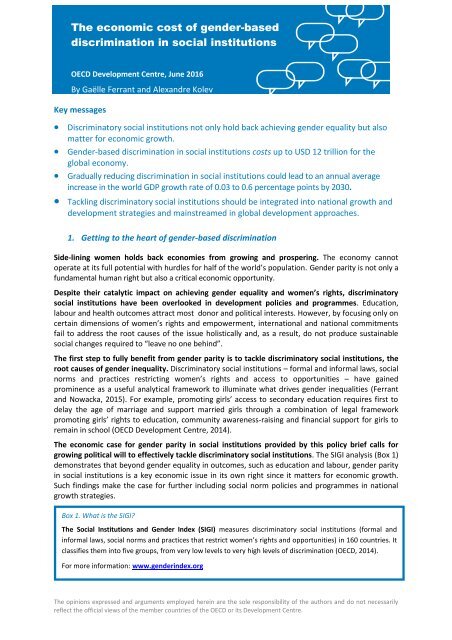2eBpQex
2eBpQex
2eBpQex
Create successful ePaper yourself
Turn your PDF publications into a flip-book with our unique Google optimized e-Paper software.
The economic cost of gender-based<br />
discrimination in social institutions<br />
OECD Development Centre, June 2016<br />
By Gaëlle Ferrant and Alexandre Kolev<br />
Key messages<br />
Discriminatory social institutions not only hold back achieving gender equality but also<br />
matter for economic growth.<br />
Gender-based discrimination in social institutions costs up to USD 12 trillion for the<br />
global economy.<br />
Gradually reducing discrimination in social institutions could lead to an annual average<br />
increase in the world GDP growth rate of 0.03 to 0.6 percentage points by 2030.<br />
Tackling discriminatory social institutions should be integrated into national growth and<br />
development strategies and mainstreamed in global development approaches.<br />
1. Getting to the heart of gender-based discrimination<br />
Side-lining women holds back economies from growing and prospering. The economy cannot<br />
operate at its full potential with hurdles for half of the world’s population. Gender parity is not only a<br />
fundamental human right but also a critical economic opportunity.<br />
Despite their catalytic impact on achieving gender equality and women’s rights, discriminatory<br />
social institutions have been overlooked in development policies and programmes. Education,<br />
labour and health outcomes attract most donor and political interests. However, by focusing only on<br />
certain dimensions of women’s rights and empowerment, international and national commitments<br />
fail to address the root causes of the issue holistically and, as a result, do not produce sustainable<br />
social changes required to “leave no one behind”.<br />
The first step to fully benefit from gender parity is to tackle discriminatory social institutions, the<br />
root causes of gender inequality. Discriminatory social institutions – formal and informal laws, social<br />
norms and practices restricting women’s rights and access to opportunities – have gained<br />
prominence as a useful analytical framework to illuminate what drives gender inequalities (Ferrant<br />
and Nowacka, 2015). For example, promoting girls’ access to secondary education requires first to<br />
delay the age of marriage and support married girls through a combination of legal framework<br />
promoting girls’ rights to education, community awareness-raising and financial support for girls to<br />
remain in school (OECD Development Centre, 2014).<br />
The economic case for gender parity in social institutions provided by this policy brief calls for<br />
growing political will to effectively tackle discriminatory social institutions. The SIGI analysis (Box 1)<br />
demonstrates that beyond gender equality in outcomes, such as education and labour, gender parity<br />
in social institutions is a key economic issue in its own right since it matters for economic growth.<br />
Such findings make the case for further including social norm policies and programmes in national<br />
growth strategies.<br />
Box 1. What is the SIGI?<br />
The Social Institutions and Gender Index (SIGI) measures discriminatory social institutions (formal and<br />
informal laws, social norms and practices that restrict women’s rights and opportunities) in 160 countries. It<br />
classifies them into five groups, from very low levels to very high levels of discrimination (OECD, 2014).<br />
For more information: www.genderindex.org<br />
The opinions expressed and arguments employed herein are the sole responsibility of the authors and do not necessarily<br />
reflect the official views of the member countries of the OECD or its Development Centre.
2. Quantifying the economic costs of discrimination in social institutions<br />
Gender-based discrimination in social institutions matters for economic growth. Previous empirical<br />
studies demonstrate that gender inequality in outcomes (Ferrant, 2015) is bad for growth, especially<br />
when it comes to gender disparities in education and labour (OECD, 2012). Many policies and<br />
regulations drive these results. Underlying all of them are discriminatory laws, social norms and<br />
practices that perpetuate gender stereotypes and mind-sets that undermine women’s<br />
empowerment. By shaping and influencing norms of acceptable behaviour and power relations<br />
between the sexes, discriminatory social institutions are additional key issues for economic growth<br />
by determining the economic choices and empowerment opportunities available for women.<br />
Gender-based discrimination in social institutions hampers a country’s income by lowering female<br />
access to education and jobs, and reducing production factor productivity. Higher levels of<br />
discrimination in social institutions, measured by the SIGI, are associated with lower levels of<br />
national income. This is explained mainly by the negative influence of discriminatory social<br />
institutions on the levels of female labour force participation and human capital. In turn, restricted<br />
women’s access to education and labour has substantial negative consequences on GDP by reducing<br />
production factor accumulation and their productivity. Indeed, given a similar distribution of innate<br />
abilities between women and men, constraints on women’s access to education and labour distort<br />
the economy by artificially reducing the pool of talent from which employers can draw, thereby<br />
reducing the average productivity of the production factor (Ferrant 2015).<br />
The current level of discrimination is estimated to induce a loss of up to USD 12 trillion or 16% of<br />
global income. Regional income losses associated with current levels of gender-based discriminatory<br />
social institutions are significant (Figure 1): about USD 6 116 billion in OECD countries,<br />
USD 2 440 billion in East Asia and the Pacific, USD 888 billion in South Asia, USD 733 billion in Eastern<br />
Europe and Central Asia, USD 658 billion in Latin America and the Caribbean, USD 575 billion in the<br />
Middle East and North Africa, and USD 340 billion in sub-Saharan Africa (Ferrant and Kolev, 2016).<br />
Figure 1. Income loss associated with discriminatory social institutions by region<br />
Notes: This figure presents the regional income losses associated with current levels of gender-based discrimination in<br />
social institutions. Income losses are measured in terms of 2011 real income at current PPP. The regional classification<br />
excludes OECD countries, which are represented as a stand-alone group.<br />
Source: Ferrant and Kolev (2016).<br />
Issues Paper: The economic cost of gender-based discrimination in social institutions OECD 2016
3. Quantifying the economic benefits of reducing gender-based discrimination in social<br />
institutions<br />
A world free of discriminatory social institutions could generate substantial macroeconomic gains<br />
benefiting all. This equal world would not only improve women’s rights and empowerment but also<br />
increase countries’ monetary living standards, as measured by their income per capita. Gender parity<br />
in social institutions could yield substantial economic benefits, leading to an annual increase in the<br />
world GDP growth rate of 0.6 percentage points by 2030. In other words, the world GDP per capita in<br />
2030 is estimated at USD 8 378 without a reduction in gender-based discrimination in social<br />
institutions, compared to USD 9 142 if discriminatory social institutions were totally eradicated. This<br />
is an impressive gain of USD 764 per capita.<br />
Moving towards greater gender parity in social institutions can also produce mid-term positive<br />
results. Eliminating all forms of gender-based discrimination in social institutions requires long-term<br />
commitments. By introducing gender-responsive policies and programmes, and gradually<br />
removing discrimination in legal frameworks and social norms, countries may improve their grades<br />
within the SIGI classification (“SIGI upgrade” scenario) or reach the SIGI score of the regional best<br />
performers (“Best-in-region” scenario). This step forward towards parity would have substantial<br />
macroeconomic gains: the world GDP growth rate would increase from 0.03 percentage points<br />
(“SIGI upgrade” scenario) to 0.2 percentage points (“Best-in-region” scenario) (Figure 2 and Box 2) .<br />
Figure 2. Income per capita gains associated with reduced levels of gender-based discrimination in social<br />
institutions<br />
Notes: This figure presents the annual increase of global GDP growth rate under three scenarios using a world with no<br />
change in levels of gender-based discrimination in social institutions between 2015 and 2030 as a benchmark.<br />
Source: Ferrant and Kolev (2016).<br />
Box 2: Levels of gender-based discrimination in social institutions: 2030 Scenarios<br />
(i) Upgrade in the SIGI classification: decrease in a country’s level of gender-based discrimination in social<br />
institutions to attain a lower group along the SIGI classification in 2030;<br />
(ii) Best-in-region: decrease in a country’s level of gender-based discrimination in social institutions to reach<br />
the regional best performer level in 2030;<br />
(iii) Gender parity: eradication of gender-based discrimination in social institutions by 2030.<br />
Source: Ferrant and Kolev, 2016.
4. Charting the way forward<br />
Discriminatory social institutions represent an important cost for economic development. Focusing<br />
only on the economic cost of gender-based discrimination in outcomes underestimates the income<br />
loss associated with gender-based discrimination.<br />
These findings make the case for further including social norm policies and programmes in national<br />
growth strategies, while helping countries identify their own specific entry points and levers to<br />
make gender equality a reality at home. Non-discriminatory and gender-sensitive laws are the first<br />
step to challenge discriminatory social institutions: the introduction of laws has seen positive impacts<br />
for decreasing early marriage (e.g. South Africa), reversing the skewed sex ratio (e.g. Korea) and<br />
increasing women’s access to land ownership (e.g. Uganda). However, laws are not enough to<br />
challenge entrenched acceptance of discriminatory social norms by communities, including women,<br />
that undermine gender equality. Fostering inclusive economies and societies notably requires a mix<br />
of policy responses that can address these deep-rooted biases: recognising, reducing and<br />
redistributing (the three “Rs”) unpaid care work, encouraging girls and women to enter traditionally<br />
“male” domains (e.g. STEM subjects), offering incentives to families to discourage early marriage of<br />
girls, and working with men and boys to combat negative stereotypes regarding working mothers.<br />
For the global community to implement the Sustainable Development Goals (SDG), addressing<br />
gender-based discrimination in social institutions will be paramount for progress. Discriminatory<br />
social institutions feature high up the priority scale in SDG Goal 5: ‘’end all forms of discrimination<br />
against all women and girls everywhere’’. The proposed indicator to track progress on this is<br />
‘’whether or not legal frameworks are in place to promote, enforce and monitor equality and nondiscrimination<br />
on the basis of sex’’. This greater inclusion of discriminatory social institutions reflects<br />
the international community’s commitments to transformative change. However, “enforcing and<br />
monitoring” these committments would be key for catalysing real and long-lasting empowerment for<br />
girls and women and providing economic gains.<br />
References<br />
Ferrant, G. and A., Kolev (2016), “Does gender discrimination in social institutions matter for longterm<br />
growth?: Cross-country evidence”, OECD Development Centre Working Paper n°330.<br />
Ferrant, G. and K. Nowacka (2015), “Measuring the drivers of gender inequality and their impact on<br />
development: the role of discriminatory social institutions”, Gender and Development, vol. 23(2),<br />
pp.319-332.<br />
Ferrant, G. (2015), “How Do Gender Inequalities Hinder Development? Cross-Country Evidence”,<br />
Annals of Economics and Statistics, Vol. 117-118, pp. 313-352.<br />
OECD Development Centre (2014), “Social Institutions and Gender Index (SIGI) 2014 Synthesis Report”.<br />
OECD (2012), Closing the Gender Gap: Act Now, OECD Publishing, Paris.<br />
For more information on our work please visit:<br />
www.oecd.org/dev/development-gender<br />
www.genderindex.org<br />
Issues Paper: The economic cost of gender-based discrimination in social institutions OECD 2016










